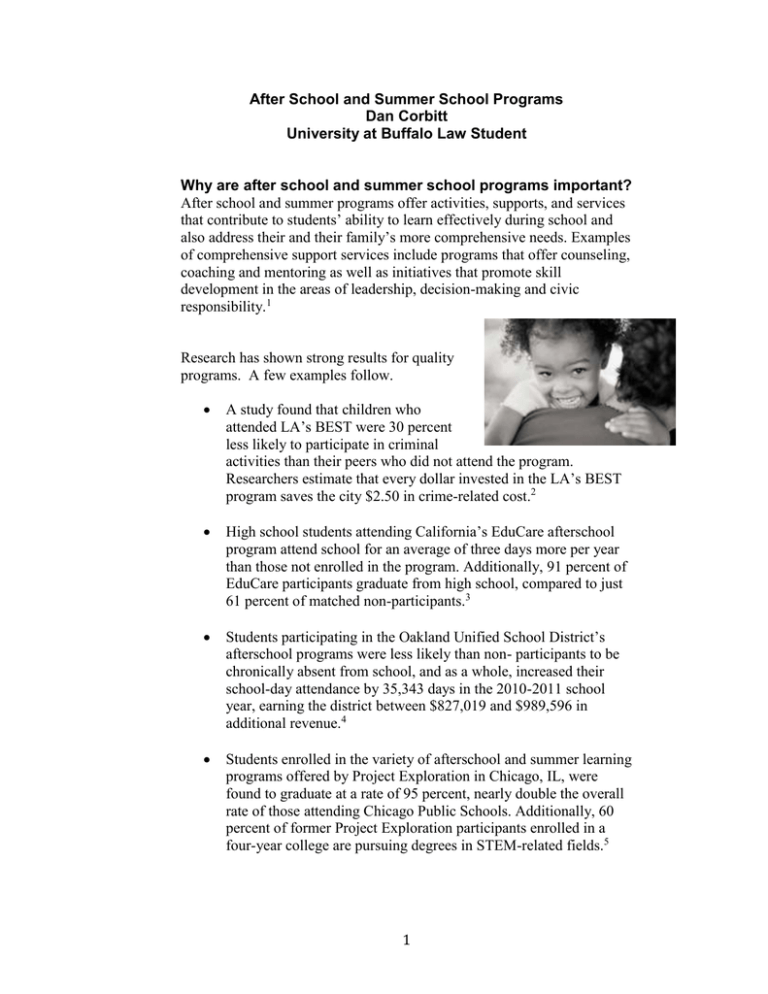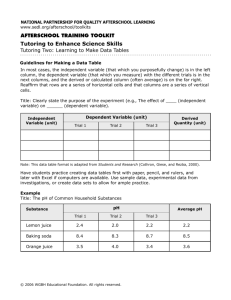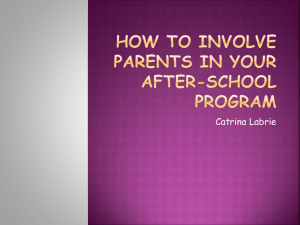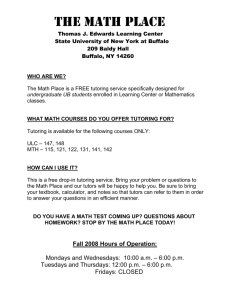after school and summer programs - bflo
advertisement

After School and Summer School Programs Dan Corbitt University at Buffalo Law Student Why are after school and summer school programs important? After school and summer programs offer activities, supports, and services that contribute to students’ ability to learn effectively during school and also address their and their family’s more comprehensive needs. Examples of comprehensive support services include programs that offer counseling, coaching and mentoring as well as initiatives that promote skill development in the areas of leadership, decision-making and civic responsibility.1 Research has shown strong results for quality programs. A few examples follow. A study found that children who attended LA’s BEST were 30 percent less likely to participate in criminal activities than their peers who did not attend the program. Researchers estimate that every dollar invested in the LA’s BEST program saves the city $2.50 in crime-related cost.2 High school students attending California’s EduCare afterschool program attend school for an average of three days more per year than those not enrolled in the program. Additionally, 91 percent of EduCare participants graduate from high school, compared to just 61 percent of matched non-participants.3 Students participating in the Oakland Unified School District’s afterschool programs were less likely than non- participants to be chronically absent from school, and as a whole, increased their school-day attendance by 35,343 days in the 2010-2011 school year, earning the district between $827,019 and $989,596 in additional revenue.4 Students enrolled in the variety of afterschool and summer learning programs offered by Project Exploration in Chicago, IL, were found to graduate at a rate of 95 percent, nearly double the overall rate of those attending Chicago Public Schools. Additionally, 60 percent of former Project Exploration participants enrolled in a four-year college are pursuing degrees in STEM-related fields.5 1 Organization Most programs share a common activity structure—a mix of homework help, snacks, free time, arts and crafts, table games, gym or playground time, a weekly activity in music or dance, cultural awareness activities, and field trips.vi Tutoring, reading time, and special curricular elements such as science activities increasingly supplement these core activities.vii Delivery These programs can be delivered through multiple methods.viii Programs serving youth require funds to cover facility, personnel, and other administrative costs as well as to develop and/or improve existing information systems technology to better track outcomes for the youth they serve.ix Program leaders need funds to conduct planning and evaluation activities and support staff training and professional development. They also need flexible resources to coordinate and collaborate with other community stakeholders in an effort to build or link systems of supports. Best practices include the following: 1) Quality programming and staffing Programs must be developed with a focus on promoting target outcomes through well-organized and engaging activities. This entails having a clear goals and objectives for the program from the start, as well as strong, directed leadership and sustained training and support to staff.x 2) Access to and sustained participation in programs Young people experience greater gains if they participate in after school programs with greater frequency and in a more sustained manner. They also benefit from programs tailored to their interests, needs, and schedules, as well as from those providing exposure to new ideas, challenges, and people.xi 3) Strong partnerships High quality programs effectively leverage partnerships with a variety of stakeholders, especially families, schools and communities.xii Funding Programs are funded by a variety of sources, from parent fees to foundation grants to taxpayer dollars. In addition, many programs rely on in-kind contributions, some of them of substantial value, such as physical space and transportation.xiii Funding for after school and summer school programs comes from a wide range of public and private sources. Public funds come from the federal, state, and local level.xiv Private funding can come from donations from individuals, private businesses, and from charging for services. Funding is 2 usually a difficult hurdle for after school and summer programs, especially in urban areas.xv As budgets get tight, these valuable programs are often the first to be cut. Current BPS afterschool and summer school programs Current afterschool and summer school programs are administered in the BPS district in a variety of ways. These programs may be specific to a particular school, or part of a regional or national system. First, many programs are developed through a partnership between individual school and nonprofit organizations. For example, the Reclaiming Buffalo Afterschool Program is made possible through the partnership between BPS and CEPA Gallery and Just Buffalo Literary Center. These not-for-profit organizations are not paid by the BPS, and instead obtain funding through a variety of public and private sources.xvi Another way that BPS implements afterschool programs is by contracting with private companies to provide services at school. For instance, the Princeton Review is a private company that provides operates ELA and Math instruction in afterschool programs at Buffalo schools. The program is available to students in grades 2-8 at sixteen locations. The buildings to be included are school 6, 18, 30, 31, 33, 37, 39, 43, 45, 59, 76, 79, 91, 94, 95, and 97. Another program made possible with a partnership between BPS and nonprofit organizations is the High School Enrichment Arts Afterschool Program (heARTS). This program provides courses in the visual arts (art entrepreneurship and bookmaking), dance (Salsa and Hip-Hop), and theater (musical theater and improvisation) through a partnership with the Western New York Book Arts Collaborative and Verve Dance Studio.xvii Other programs are administered through a partnership between local colleges and universities and BPS. For example, Buffalo State College collaborated with BPS to create a program to improve science and math through the Supplemental Educational Services (SES) literacy tutoring program. SES is a federally-funded program designed specifically for eligible students attending under- performing schools. As part of No Child Left Behind regulations, the SES program allows school districts to contract with agencies and organizations to provide outside tutoring/remediation in reading and mathematics. The SES program of Buffalo State College focuses on English/Language Arts for students in grades K – 8 attending Buffalo Area Schools.xviii 3 Another successful program was developed through a partnership between BPS and D’Youville College with funding through the US Department of Health and Human Services. The Nursing Workforce Diversity Program promotes academic achievement and prepares disadvantaged students for entry into and graduation from a professional nursing program.xix The program is available for students at East High School. Programs may result from a partnership between BPS and local businesses. For example, Hillside Work-Scholarship Connection is a partnership between school districts, local businesses and other area leaders to provide to tackle some of the most difficult challenges that students face outside the classroom, working to ensure students come to school ready to learn. As part of the program, students get placed in afterschool jobs at local businesses such as supermarkets. In 2009, the Youth Policy Forum recognized the program as one of the nation’s most effective youth development programs to “Support Youth on the Path to College and Beyond.”xx In the Back to Basics program, approximately 100 youth (either court mandated or brought by concerned schools/parents) between the ages of 13-21 will participate with mentors to navigate out of harmful situations. Mentors provide counseling, field trips, and a positive social role model. The program also provides academic tutoring, spiritual enrichment, and maintenance of regular school attendance are provided as well. Twice a month, workshops for gang and drug involved youth are held to immerse them in positive, alternative activities.xxi Programs planned for the future Buffalo Arts and Technology Center (BATC) is a collaboration between the Manchester Bidwell Corporation and Artspace. Programs will focus on high-quality visual, studio-based arts; digital and design arts programming. Expected partnerships with the local health care sector will ensure that market-relevant career training opportunities possibly in currently hard-to-fill employment areas, such as electronic records management, medical assistants and pharmacy technician training. Say Yes Buffalo plans to provide comprehensive out-of-school supports, including after-school tutoring and summer learning opportunities, that extend learning time for students and place service coordinators in every school. Buffalo Promise Neighborhood will provide a continuum of solutions to children and families from the cradle through college and career through neighborhood resources, streamlining family services, and improving 4 educational supports. This may also include after school and summer programs. 1 R. Catalano et al., Positive Youth Development in the United States: Research Findings on Evaluations of Positive Youth Development Programs (Washington, D.C.: U.S. Department of Health and Human Services, Office of the Assistant Secretary for Planning and Evaluation, November 1998) 2 Id. 3 Id. UCLA National Center for Research on Evaluation, Standards and Student Testing, September 2007 5 Id. vi Id. vii Id. viii Sharon Deich, A Guide to Successful Public-Private Partnerships for Out-of-School Time and Community School Initiatives (Washington, D.C.: The Finance Project, 2001). 4 ix Id. Goldschmidt, P., Huang, D., & Chinen, M. (2007). The long-term effects of after-school programming on educational adjustment and juvenile crime: A study of the LA’s BEST after-school program (Unpublished Manuscript). Los Angeles: University of California, National Center for Research on Evaluation, Standards, and Student Testing (CRESST) xi Id. xii Id. xiii Nanette Relave, Finding Funding: A Guide to Federal Sources for Workforce Development Initiatives (Washington, D.C.: The Finance Project, June 2005). xiv Id. xv Id. xvi http://www.cepagallery.org/information/mission.html xvii http://www.thegoodneighborhood.com/2011/11/01/where-the-heart-is-public-schoolsand-nonprofits-partner-on-hearts-programs/#sthash.LIiTZgoX.dpuf xviii http://www.buffalostate.edu/ceure/documents/SESAPPFALL2012.pdf xix Funding opportunities brief isp.sdccd.edu/grants/pdfs/funding/Nursing_Workforce_Diversity.pdf x xx xxi http://www.hillside.com/BPSAnnouncement.aspx#sthash.n31UeAli.dpuf http://www.topix.com/yp/buffalo-ny/l-98878637f-back-to-basics-outreach-minist 5




